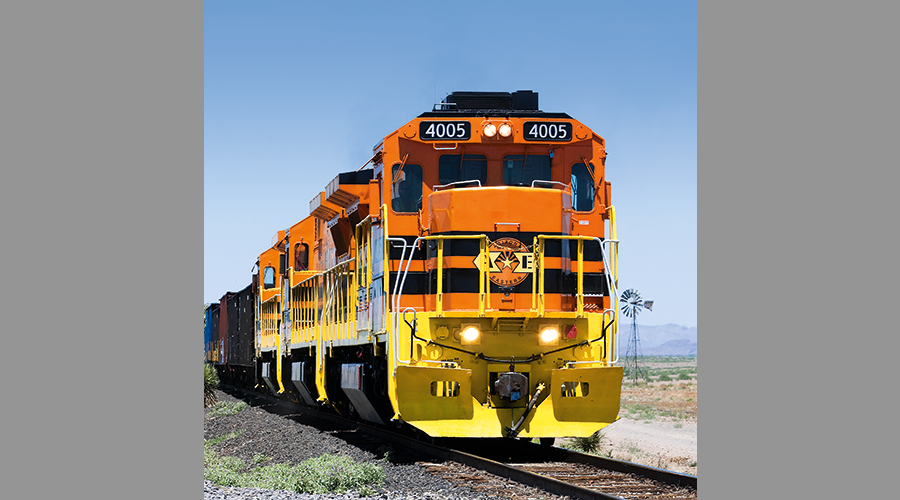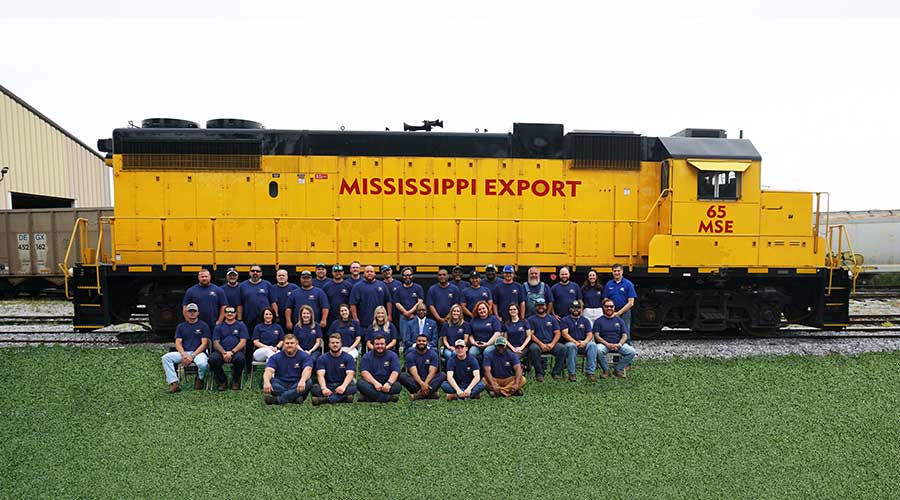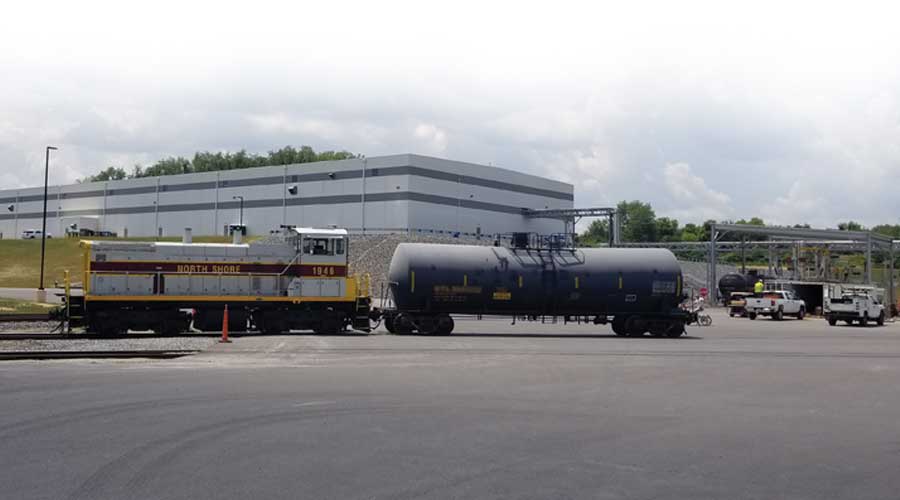Stay updated on news, articles and information for the rail industry
July 2013
Rail News: Short Lines & Regionals
Crude oil surge in Permian Basin drives Texas-style business boom for short-line railroad
— by Jeff Stagl, Managing Editor
On a sunny and hot mid-June day in Big Lake, Texas, more than 100 empty hopper cars stretching farther than the naked eye can see were staged along several miles of track, prepped for a return trip to Illinois and Wisconsin frac sand mines. Twenty miles east in Barnhart, dozens of tank cars loaded with crude oil and destined for Houston-area refineries were stationed on three long tracks as drills maintained their monotonous up-and-down motion at a half-dozen wells operating nearby.
The activity visible in west-central Texas is a small part of the big oil boom in the Permian Basin, a crude-rich sedimentary deposit covering a 250-mile-wide, 300-mile-long portion of the Lone Star State and New Mexico. The basin already is home to hundreds of wells and is projected to gain 4,000 more of them by 2016.
That adds up to a promising present and future for Texas Pacifico Transportation Ltd. (TXPF), a short line that's eagerly tapping into Big Lake, Barnhart and other parts of the growing basin. The well-known real estate mantra best explains what the railroad is trying to exploit to become a significant crude tapper: location, location, location.
TXPF operates the state of Texas-owned South Orient rail line, which runs 391 miles from San Angelo Junction to Presidio, Texas, reaching the state's border with Mexico and piercing the heart of the basin. Headquartered in San Angelo, Texas, TXPF is owned by Grupo México S.A. de C.V., a Mexican mining conglomerate that also controls 74 percent of Ferrocarril Mexicano S.A. de C.V. (Ferromex), the other 26 percent of which is owned by Union Pacific Railroad.
After it was formed in March 2001 to operate the South Orient line via a 30-year lease agreement with the Texas Department of Transportation (TxDOT) and South Orient Rural Rail Transportation District, TXPF didn't generate much traffic for the next 10 years. But in 2011, frac sand and crude oil operations began to blossom in the basin, helping the short line quadruple 2010 carloads to 4,000.
Last year, TXPF's carloads tripled to 12,000 and the short line posted its first-ever profit, at $1.5 million. This year, carloads are projected to nearly triple again to more than 30,000, followed by a forecasted rise to 40,000 or 50,000 in 2014.
Call(s) For Action
Since frac sand and crude oil now account for 60 percent and 20 percent of total traffic, respectively, TXPF's volume figures to keep booming right along with the basin.
"I get a call a day. It's the sand people and the oil people and the pipe people and the hydrochloric acid people — pretty much the people involved in every aspect of drilling," says Federico Díaz-Page, the short line's executive vice president.
The inquiries about rail-served sites for crude or frac sand operations poured in so frequently last year, Díaz-Page in October 2012 hired Elizabeth Miller Grindstaff as vice president of sales and marketing. Formerly San Angelo's assistant city manager, Miller Grindstaff now fields the calls and handles business development.
"We're not really out there selling. We're in reactive mode," she says. "My role is to react to the interest shown, to answer the questions and to find the real estate that suits customers."
Back To The Border
Interest levels likely will continue to pick up through 2013, and not just from oil industry constituents. The coming resurrection of a key bridge signals TXPF's resumed participation in traffic moving across the U.S./Mexican border, which is anticipated to generate numerous inquiries from shippers.
The Presidio-Ojinaga International Rail Bridge, which crosses the Rio Grande River between Presidio, Texas, and Ojinaga, Mexico, was nearly destroyed by a fire in February 2008. The bridge is slated to be rebuilt by late 2014 or mid-2015 per an agreement between TxDOT and the Mexican government. The new bridge will enable TXPF to resume an interchange with Ferromex, helping to build regional traffic between points in the state of Chihuahua, Mexico, and west Texas, such as for cement produced in Mexico and moved north.
In addition, the short line will be able to better develop and build upon an interchange with UP in Alpine, Texas. TXPF also interchanges with BNSF Railway Co. and the Fort Worth & Western Railroad in San Angelo Junction.
Although business is growing at a "fast but manageable rate," it's vital that the traffic growth isn't heavily tied to one commodity — even crude, says Miller Grindstaff. Prior to the basin boom, the short line was dependent on agricultural products, primarily grain. Now, opportunities are emerging for additional lumber, metals, steel and other traffic.
"We're mindful that a mix of commodities will be healthy," says Miller Grindstaff.
TXPF's management team also is trying to be mindful of the resource-stretching effects from over-explosive traffic growth — especially since the short line's annual volume could reach a summit of 60,000 by 2016, says Díaz-Page.
It's vital the railroad has enough manpower, infrastructure capacity and rolling stock, he says. Since early 2012, the short line's number of employees has ballooned from eight to 80 and number of leased locomotives has jumped from six to 24.
"We've been growing so fast, it makes it difficult to digest," says Díaz-Page.
What made things especially difficult to stomach for Díaz-Page and his management team members — including Superintendent of Operations Eddy Arias and Operations Support Manager Jaime Ontiveros — was that the short line wasn't well prepared to take on more business when they all arrived in early 2012. No proper work processes were in place and a lot of required paperwork wasn't completed, says Díaz-Page.
"There was nothing in place to measure anything. Overtime? Fuel burn? They got used to fixing things as they popped up," he says.
The short line was facing $100 million in Federal Railroad Administration fines, mostly because of a lack of documentation, but after nine painstaking months of completing paperwork, the fines were reduced to $37,000, says Arias.
Finders, Keepers
The management team also created a four-week training program for new employees since no formal one was in place, he says. The program will help TXPF retain workers, which has been difficult of late: About three out of five new hires quit in less than a year after experiencing the 24/7 work environment.
Recruitment has been problematic, too. The short line is competing for candidates with local oil and sand companies, which can offer a starting wage of $21 to $23 per hour compared with TXPF's $17, says Arias.
Recruiting will be more of a challenge next year because the short line will need 300 to 350 more workers — or four-fold the current number of employees — after the Presidio-Ojinaga bridge is replaced, he says. The rail industry's strong retirement program and short line's benefit package will help lure candidates, Arias believes.
"We provide a bonus every year and cover 100 percent of insurance costs for health, dental and vision," he says.
Bolstering Ties With BNSF
Another challenge the management team continues to address: TXPF's relationship with BNSF. The short line and Class I currently interchange five units trains of frac sand each week in San Angelo Junction, and overall interchange six days per week compared with once per week prior to 2012.
There previously were arguments about service issues, in part because BNSF managers got used to TXPF's low traffic volume — 1,000 or fewer cars annually — for 10 years, says Arias. Now, BNSF and TXPF managers communicate via conference call once a week and continue finding ways to work out service kinks, he says.
"They see that we have rail experience now," says Arias, who previously served Canadian Pacific for many years in various roles, including conductor, engineer and maintenance-of-way supervisor. (Díaz-Page's work history includes an eight-year stint at TFM S.A. de C.V. in a variety of roles, including chief transportation officer.)
The management team also is trying to clear perhaps its biggest hurdle by updating and improving the South Orient line, which was established in 1897. Last year, TXPF poured its first-ever profit back into the railroad, says Díaz-Page. Wood ties dating back to 1929 and 1939 were replaced, some bridges were fixed and some new rail was installed, all of which helped boost train speed from 10 mph to 25 mph on much of the line.
The railroad plans to increase train speed to 40 mph in some locations, but about one-third of the line still needs repairs, says Arias.
TXPF will gain some much-needed line improvements if the U.S. Department of Transportation approves a $6.4 million Transportation Investment Generating Economic Recovery (TIGER) V grant that TxDOT applied for in May.
The TIGER V grant would help fund a $13.6 million project on the South Orient line between Sulphur Junction and Fort Stockton, for which TXPF would contribute $6.8 million, the Fort Stockton Economic Development Corp. would provide $200,000 and TxDOT would kick in $170,000, says Gil Wilson, a TxDOT rail specialist.
More Structured Infrastructure
For now, TXPF expects to spend about $20 million of its own funds this year to improve infrastructure. The railroad plans to replace more 70-pound rail with much heavier rail, says Díaz-Page, adding that replacement efforts have been ongoing.
In addition, a good chunk of the dollars will be used to enlarge sidings in Alpine to improve the short line's interchange with UP prior to the completion of the new Presidio-Ojinaga bridge.
TXPF also plans to extend sidings in San Angelo to improve interchanges with BNSF and the Fort Worth & Western, and build a siding and switches in Barnhart to improve crude and frac sand service in the basin.
"We are wasting time switching off of our mainline," says Ontiveros, the operations support manager, adding that the Barnhart siding will enable trains to keep moving without delays.
Some of TXPF's crude-related customers are focusing on rail infrastructure expansions, as well. Muskett Corp. plans to spend $40 million to build tracks and other rail infrastructure to accommodate 80-car unit trains at its crude oil operation in Barnhart; Badger Mining Corp. plans to spend several million dollars to build eight tracks at its San Angelo frac sand operation; Texas Specialty Sands L.L.C. already is building six to eight more tracks at its Barnhart frac sand operation; and EOG Resources Inc. plans to revise rail infrastructure at its Barnhart facility to move 91-car instead of 80-car unit trains of crude.
With a number of shippers expected to continue adding carloads to TXPF's traffic ledger, the management team is trying to get a handle on exactly where the volume will be coming from, and in some cases, precisely what will be moved. For example, team members have held discussions with Angelo State University officials about conducting a market study next year pertaining to the rebuilt bridge's regional impacts, says Miller Grindstaff.
"We'd like to see what opportunities there are," she says.
Finding opportunities isn't as much of an issue as seizing them. There's only so much more TXPF can take on, says Díaz-Page.
"My job is to open customers' eyes, and to not take it that far," he adds.
Now that the short line is operating more efficiently, TXPF at least can take on a lot more business than it could have several years ago.
"It's a lot easier to manage the railroad today," says Díaz-Page. "We've been able to serve every customer."


 2025 MOW Spending Report: Passenger-rail programs
2025 MOW Spending Report: Passenger-rail programs
 Gardner steps down as Amtrak CEO
Gardner steps down as Amtrak CEO
 Guest comment: Oliver Wyman’s David Hunt
Guest comment: Oliver Wyman’s David Hunt
 Women of Influence in Rail eBook
Women of Influence in Rail eBook
 railPrime
railPrime







